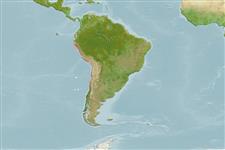Common names from other countries
Environment: milieu / climate zone / depth range / distribution range
Écologie
; profondeur 0 - 20 m (Ref. 114693). Tropical, preferred 15°C (Ref. 107945); 5°S - 43°S, 81°W - 70°W (Ref. 114682)
Distribution
Pays | Zones FAO | Écosystèmes | Occurrences | Introductions
Southern Pacific: From Sechura, Peru to Chiloé, Chile. Tropical and subtropical.
Length at first maturity / Taille / Poids / Âge
Maturity: Lm ? range ? - ? cm Max length : 7.0 cm ShL mâle / non sexé; (Ref. )
Lives in the swash zone of exposed high-energy intermediate and dissipative sandy beaches. Usually burrows to a depth of around 10 cm, but can reach 25 cm if disturbed. Adults are mainly restricted to the surf zone while most of the juveniles to the swash zone (Ref. 106909). Intertidal to subtidal (Ref. 113820).
Life cycle and mating behavior
Maturité | Reproduction | Frai | Œufs | Fécondité | Larves
Members of the class Bivalvia are mostly gonochoric, some are protandric hermaphrodites. Life cycle: Embryos develop into free-swimming trocophore larvae, succeeded by the bivalve veliger, resembling a miniature clam.
SAUP Database. 2006. (Ref. 356)
Statut dans la liste rouge de l'IUCN (Ref. 130435)
statut CITES (Ref. 108899)
Not Evaluated
Not Evaluated
Utilisations par l'homme
Pêcheries: commercial
FAO - pêcheries: landings | FishSource | Sea Around Us
Outils
Plus d'informations
Taille/ÂgeCroissanceLongueur-poidsLongueur-longueurMorphologieLarvesAbondance
Sources Internet
Estimates based on models
Preferred temperature
(Ref.
115969): 11.8 - 21.9, mean 17.4 (based on 30 cells).
Résilience
Haut, temps minimum de doublement de population inférieur à 15 mois (K=1.13).
Vulnérabilité
Low vulnerability (10 of 100).
